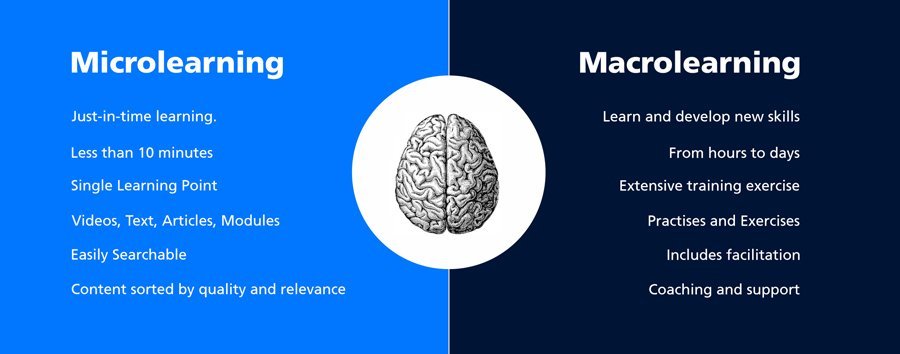Microlearning vs. Macrolearning
Microlearning vs. Macrolearning is the oldest debate in the industry. Recently, microlearning has shown to outshine macrolearning. But before coming to any conclusions, it is important to note that both micro and macrolearning are essential in their own way.
Corporate training is one of the most important aspects of every organization. Leaders and decision-makers apply periodical learning to prepare their employees for various job responsibilities. They apply microlearning and macrolearning to create powerful L&D programs. This way, they increase the chances of successful client interaction, whether they’re running a banking, finance, or insurance institution.
Owing to digital transformation and technological breakthroughs, businesses are no longer restricted to traditional learning methods, also known as macrolearning. They can switch to a more streamlined approach called microlearning. It helps owners cut costs, offers flexibility and accessibility, and allows them to easily keep track of their team’s progress.
In this entry, we’ll explore all the reasons why microlearning is superior to conventional learning techniques.
What Is Macrolearning?
Macrolearning dives deep when it comes to learning and training. Traditional methods usually include instructors and physical assets, such as notes, books, and references. Learners follow continuous training models for an extended period and become familiar with their training goals.
As a consequence, long-term models often deflect from desired paths. This is because the approach requires in-depth implementation, analyses, and a team of experts. Controlling so many factors often lead to a lot of shortcomings that can impair the learning process.
What Is Microlearning?
Microlearning is a much more compact knowledge form divided into several small chunks and served to learners. Participants can only access certain information for specific jobs, making this method highly relevant to their responsibilities. There’s often visual and audio assistance to accommodate various types of learners and make the experience engaging. Additionally, trainers can easily harmonize learning objectives with specific job goals, helping learners improve their skills.
A comparison: Microlearning vs. Macrolearning

What Makes Microlearning the Better Approach?
Microlearning sessions are structured much better than traditional methods. By following the direction in which corporate learning and development are going, it outshines macrolearning in multiple aspects:
Clearly Defined Goals
Microlearning modules break down complicated ideas into easily digestible parts. Thus, learners can achieve their goals faster without being distracted from day-to-day tasks. This means that the participants enter their training with a set objective.
Take employee onboarding as an example. It’s a simple form of microlearning and does a great job at helping new recruits understand the obligations their daily job entails. Here, the objective is to teach them how to complete their duties rather than elaborate on unrelated details. The end result is a better connection between the learner and manager, leading to a fruitful collaboration.
Faster Delivery
Due to the training size, delivering e-learning curricula through microlearning is a lot easier. People can focus better on the subject matter during short sessions since they don’t have to take hour-long courses on similar subjects. In addition, concise learning allows managers to implement changes faster as their goals change and new regulations emerge.
While extended courses often feel like tedious chores, microlearning lets your employees achieve their goals faster and keeps them engaged. There are also minimal distractions, ensuring they stay locked in throughout the modules.
Higher Knowledge Retention
Shorter training is more conducive to high knowledge retention. Since microlearning courses only deliver one or two objectives at a time, the chances of confusion are slim to none. Moreover, the length of the programs allows the participants to revisit them and revise whenever necessary.
Additionally, your employees get to learn at their own pace because there are only small data chunks they have to memorize. Also, microlearning is a gradual process, enabling the users to reinforce their goals step-by-step and integrate the newly acquired skills into their jobs.
Responsive Content
Your employees appreciate customized, responsive content relevant to their interests. They aren’t fond of going through hundreds of pages just to find one piece of information. With microlearning, they receive data more efficiently since it’s concise and addresses their work goals.
Millennial-friendly
Millennials will soon make up more than 50% of the global workforce, and their generation heavily relies on technology. They assimilate information better when presented electronically since it suits their needs, and the training platform isn’t as formal as traditional settings. Bite-sized learning meets these two criteria, making microlearning perfect for providing critical employee development.
To add even more appeal to microlearning, trainers are integrating engagement-amplifying tactics into their formats. They are deploying modules that resemble social media and creating feedback platforms that keep audiences engaged throughout their training. Plus, modern approaches also incorporate E-learning due to its accessibility using proven communication modes.
Microlearning Addresses Short Attention Spans
One of the most popular microlearning tactics is diving straight into how-to training sections and eliminating background information since learners can access it by themselves. However, the primary reason for this is that memory capacity and attention spans are best when information is presented for three to seven minutes. Learners are more likely to absorb and understand materials delivered within this time frame.
Furthermore, work environments often come with interruptions, such as urgent queries and phone calls. Generally, your staff can be locked in for about eleven minutes without breaks. Shorter modules that last approximately seven minutes are therefore ideal. They prevent workers from tuning off while completing longer sessions. Compact training lets them pick up essential skills and knowledge in double-quick time so that they can get back to their usual daily routines and remain productive.
Use of Media and Visuals
The inclusion of visuals and various media makes training materials more engaging, helping your worker retain crucial information. Many people have a hard time concentrating on blackboards with a bunch of bland words, especially if they’re dealing with complex subjects. Using infographics and videos helps your employees keep their focus and understand topics better. Microlearning modules come with ample visuals, providing your organization with an opportunity to make learning fun and appealing.
Microlearning Is the Way of the Future
Macrolearning is largely outdated, and most people aren’t fond of extended lectures in their workplace. Switching to microlearning sessions will get you on the right track to efficient and successful employee training. It maximizes the potential of any learning material by making it engaging and easy to absorb.
To get your custom-made microlearning solutions, reach out to Learnsure. We offer corporate training of the highest quality to help your organization thrive. Book your demo now, and get your hands on a premium learning solution.
